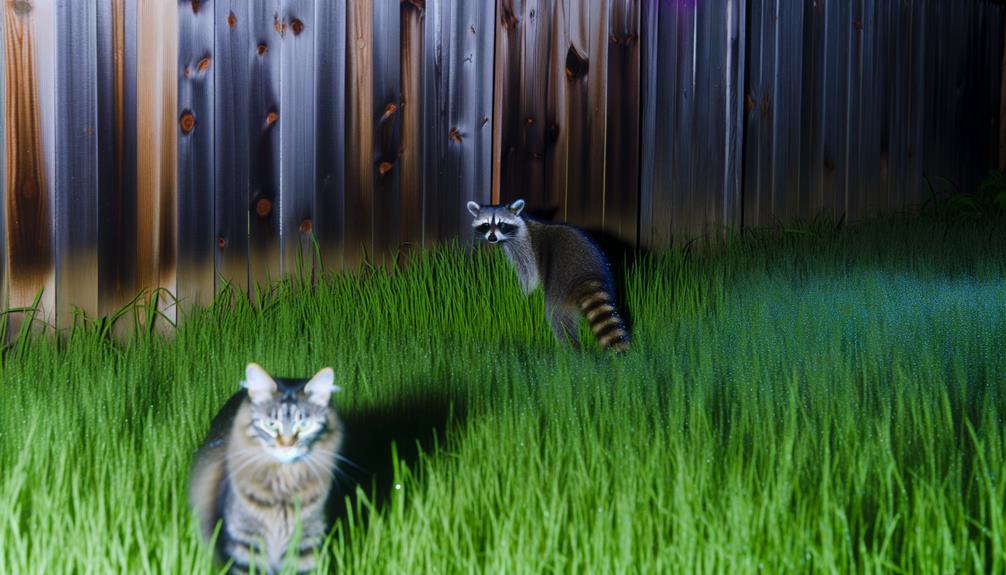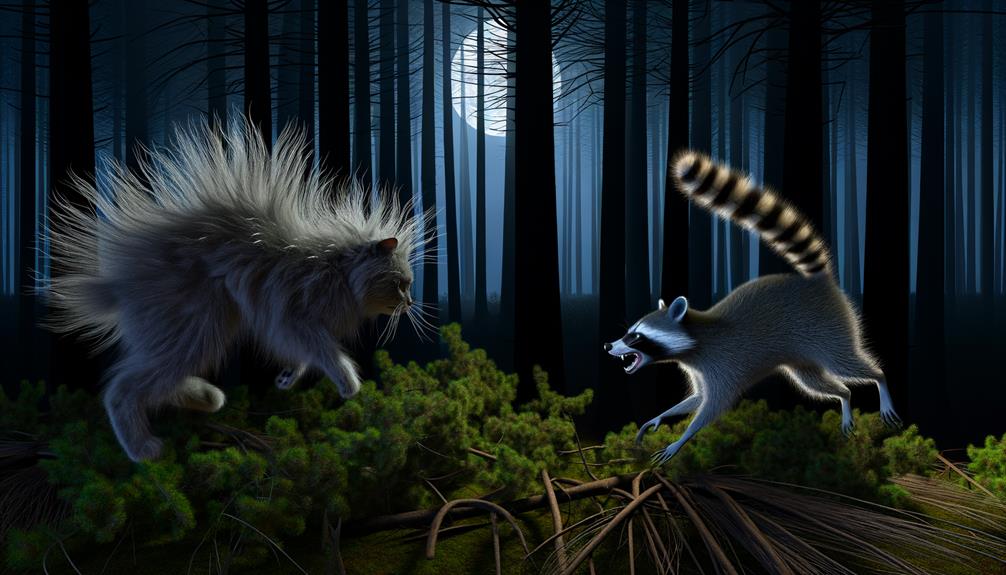How to Prevent Raccoons from Eating Your Cat
Raccoons are omnivorous and have been known to prey on smaller vertebrates, which can include domestic cats, especially kittens. Their nocturnal habits and advanced problem-solving skills enable them to exploit various environments, from urban areas to forests.
While adult cats possess agile defenses such as sharp claws and acute senses, they may still be at risk during territorial disputes over food. Preventative measures, like motion-activated lights and predator-proof fencing, can greatly reduce this risk.
For thorough strategies to safeguard cats from potential raccoon encounters and to understand the dynamics of their interactions, investigate further.

Key Takeaways
- Raccoons are generally opportunistic feeders and prefer easier prey over cats.
- Cats are agile and have sharp claws, making them difficult targets for raccoons.
- Raccoons typically avoid confrontations with animals their own size or larger.
- Territorial disputes over food can lead to aggressive interactions but not usually predation.
- Preventative measures like enclosed outdoor environments can reduce the risk of raccoon attacks on cats.
Understanding Raccoon Behavior

Raccoon behavior is characterized by their omnivorous diet, nocturnal activity, and adept problem-solving abilities.
These animals exhibit a high degree of intelligence, often manipulating objects and solving complex puzzles to access food.
Nocturnal by nature, raccoons are most active during the night, which aids in avoiding predators and human encounters.
Their forepaws are highly dexterous, resembling human hands, enabling them to open containers and doors.
Social structure varies, with males typically more solitary while females may form groups with their offspring.
Communication involves vocalizations, body language, and scent markings.
Their adaptability to diverse environments, from urban areas to forests, underscores their ability to exploit various resources, ensuring their survival across different habitats.
Typical Raccoon Diet
Given their omnivorous nature, the diet of raccoons is remarkably diverse and opportunistic, encompassing a wide range of plant and animal matter. Raccoons consume foods based on availability and seasonality, often foraging in urban and rural environments.
Their diet includes:
- Fruits and berries: Apples, cherries, grapes, and wild berries.
- Invertebrates: Insects, worms, and crustaceans like crayfish.
- Small vertebrates: Frogs, fish, and occasionally birds and their eggs.
- Plant matter: Nuts, seeds, and various grains.
- Human food waste: Scraps and leftovers from garbage bins.
This dietary flexibility aids their survival across diverse habitats. Understanding what raccoons eat provides essential insights into their ecological role and interactions with human environments.
Raccoon Hunting Patterns

The nocturnal hunting patterns of raccoons are characterized by their opportunistic and highly adaptable nature, allowing them to exploit a variety of food sources in different environments. Typically active during the night, raccoons use their acute sense of smell and dexterous paws to locate and capture prey or scavenge for food. They exhibit a preference for areas abundant in resources, including urban settings where human waste provides an easy meal. The following table outlines key aspects of raccoon hunting behavior:
| Aspect | Description |
|---|---|
| Activity Period | Nocturnal (active during the night) |
| Preferred Habitats | Urban areas, forests, wetlands |
| Hunting Techniques | Foraging, scavenging, utilizing sense of smell and tactile exploration |
Their ability to adapt to diverse environments underscores their success as a species.
Interaction With Other Animals
Understanding raccoon hunting patterns provides valuable context for exploring their interactions with other animals, which can range from predatory behavior to avoidance and coexistence. Raccoons are opportunistic feeders and display a wide range of interactions depending on the species they encounter. Scientific observations note that these interactions are influenced by various factors, including the availability of food sources and environmental conditions.
- Predatory Behavior: Raccoons may hunt smaller animals, including rodents and birds.
- Avoidance: Larger predators such as coyotes often pose a threat, leading raccoons to avoid them.
- Coexistence: In urban areas, raccoons frequently coexist with domestic pets.
- Territorial Disputes: Competition for food can lead to conflicts with other scavengers.
- Symbiotic Relationships: Occasionally, raccoons engage in mutualistic interactions, such as with certain bird species.
How Cats Defend Themselves

Cats employ a variety of defense mechanisms, including sharp claws, agility, and keen senses, to protect themselves from potential threats. Their retractable claws serve as formidable weapons, capable of inflicting significant injury on an aggressor. Agility allows cats to perform rapid and nimble movements, enabling them to evade predators effectively.
In addition, their acute senses of hearing, sight, and smell enhance their ability to detect danger early. The feline's highly developed nervous system facilitates swift reflexes, allowing them to respond almost instantaneously to sudden threats. Cats also utilize vocalizations, such as hissing and growling, to intimidate potential attackers.
Besides, their fur can puff up to make them appear larger and more formidable, deterring would-be predators.
Signs of Potential Danger
Identifying signs of potential danger involves observing specific behavioral and environmental cues that may indicate a threat to a cat's safety. Raccoons, being nocturnal and opportunistic feeders, often exhibit certain behaviors when near potential prey. Monitoring these indicators can help in evaluating the risk level.
Increased nocturnal activity:
Raccoons are more active at night and may be seen more frequently in the vicinity.
Tracks and droppings:
Presence of raccoon tracks or feces around the yard or home.
Scavenged food:
Signs of rummaged garbage or pet food dishes being disturbed.
Aggressive behavior:
Raccoons displaying unusual boldness or aggression towards humans or pets.
Distress in cats:
Cats showing signs of anxiety, hiding, or vocalizing unusually.
Observing these signs can help in early detection of potential hazards.
Preventing Raccoon Encounters

Preventing raccoon encounters involves several strategic measures to reduce attraction to residential areas. Securing outdoor trash, eliminating accessible food sources, and installing motion-activated lights are effective methods to deter raccoons.
These practices can notably decrease the likelihood of raccoon interactions, thereby enhancing the safety of domestic pets such as cats.
Secure Outdoor Trash
Securing outdoor trash is a critical step in minimizing encounters with raccoons, as these animals are highly attracted to easily accessible food sources. Raccoons possess dexterous paws and sharp intelligence, enabling them to open loosely secured garbage containers. Implementing effective strategies to secure trash can markedly reduce raccoon visits.
Key measures include:
- Use raccoon-proof garbage cans: Equipped with tight-fitting lids and locking mechanisms.
- Place trash in a secure location: Such as a locked shed or garage.
- Double-bag food waste: To minimize odors that attract raccoons.
- Avoid overfilling bins: Ensuring lids can close completely.
- Regularly clean trash bins: Reducing residual food odors.
Eliminate Food Sources
Reducing the availability of food sources in and around your property is essential in preventing raccoon encounters. To achieve this, make sure that pet food is not left outside overnight, as it can attract raccoons.
Bird feeders should be placed high and away from accessible areas; spilled seeds should be promptly cleaned. Compost piles should be securely covered to deter scavenging. Additionally, fruit trees should be regularly maintained to remove fallen fruits that might attract these nocturnal animals.
Gardens can be protected with raccoon-proof fencing. Finally, it is vital to seal any entry points to attics, basements, and sheds where raccoons might seek shelter and food. Implementing these measures can greatly reduce the likelihood of raccoon incidents.
Install Motion Lights
Motion-activated lights are an effective method for deterring raccoons by startling them with sudden illumination, thereby discouraging their approach to the area. These lights exploit the nocturnal nature of raccoons, causing discomfort and prompting them to seek less illuminated environments.
When installing motion lights, consider the following:
- Placement: Position lights near entry points and potential hiding spots.
- Sensitivity: Adjust sensitivity to detect smaller animals, yet avoid false triggers.
- Duration: Set the light to stay on long enough to deter raccoons effectively.
- Coverage: Guarantee the light covers a wide area to maximize deterrence.
- Energy Source: Opt for solar-powered options to reduce energy costs.
Safe Outdoor Spaces for Cats
Creating safe outdoor spaces for cats involves designing enclosed environments that prevent access by predators, such as raccoons.
Utilizing predator-proof fencing can substantially reduce the risk of encounters, ensuring that cats can enjoy outdoor activities without the threat of harm.
Such measures are critical for maintaining the safety and well-being of domestic cats in areas with prevalent wildlife.
Enclosed Outdoor Environments
An enclosed outdoor environment, often referred to as a 'catio,' provides a secure space for cats to enjoy the outdoors while minimizing the risk of encounters with predators such as raccoons. These structures are designed to offer a stimulating yet safe environment, ensuring the well-being of domestic cats.
Catios can vary in complexity and size, from simple window boxes to elaborate multi-level enclosures.
Key advantages of catios include:
- Enhanced Safety: Protection from predators and traffic.
- Mental Stimulation: Access to natural sights and sounds.
- Physical Exercise: Opportunities for climbing and exploring.
- Health Benefits: Reduced exposure to parasites and diseases.
- Owner Peace of Mind: Assurance of a controlled environment.
Predator-Proof Fencing
To further enhance the safety of outdoor spaces for cats, predator-proof fencing serves as a critical barrier to prevent encounters with potential threats such as raccoons. These specialized enclosures are designed with materials and structural features that deter climbing and digging, common behaviors exhibited by raccoons. Typically constructed from robust wire mesh, the fences should extend underground to prevent burrowing and be equipped with overhangs to thwart climbing attempts.
Additionally, the inclusion of electric wire along the top edge can provide an extra deterrent. Such fencing not only safeguards cats from raccoons but also from other predators, creating a secure environment. Implementing these measures notably reduces the likelihood of harmful interactions and promotes the well-being of domestic cats in outdoor settings.
Emergency Actions if Attacked

In the event of a raccoon attack on a cat, immediate actions should be taken to separate the animals and guarantee the safety of both parties. Minimizing harm requires swift and deliberate steps:
- Stay Calm: Panicking can worsen the situation.
- Create Noise: Loud sounds can startle and discourage the raccoon.
- Use a Barrier: A large object like a broom can help separate them.
- Wear Protective Gear: Gloves and long sleeves can prevent bites and scratches.
- Seek Veterinary Care: Immediate medical attention is important for injury assessment and rabies prevention.
Understanding these steps can greatly reduce the risk of severe injury and ensure both the cat and raccoon are handled safely and effectively.
Conclusion
In summation, raccoons rarely regard cats as prey, preferring their routine diet of rodents, insects, and fruits. Raccoon encounters with felines, while infrequent, can occasionally end in aggression, especially if food or territory is threatened.
Cats, equipped with claws and quick reflexes, can often defend themselves effectively. However, watchfulness and precautionary measures are crucial in minimizing potential dangers.
Creating secure outdoor spaces and understanding raccoon behavior notably decreases the likelihood of harmful interactions.






